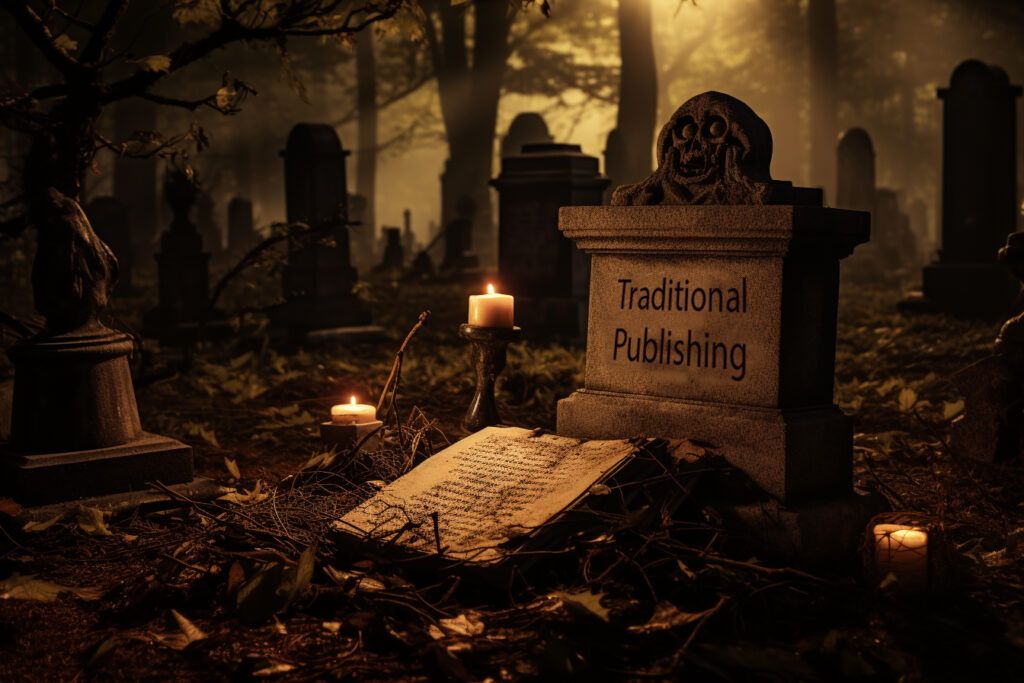
In the ever-shifting landscape of literature, the venerable traditions of traditional publishing find themselves at a crossroads. As we stand on the brink of a new decade, the industry is in the throes of a profound transformation—one that raises a compelling question: Is Traditional Publishing Dying? Our Ten-Year Forecast ventures into the heart of this inquiry, examining the seismic shifts that are reshaping the foundations of an age-old institution.
The economic strains, changing desires of authors, the relentless rise of alternative models like self- and hybrid publishing, and a reluctance to embrace new technologies—all cast shadows on the once-unquestioned dominance of traditional publishing. In this exploration, we delve into the intricacies of these challenges, foreseeing a landscape where the traditional order as we know it might cease to exist by 2030.
Yet, in the face of this upheaval, emerges a new narrative—a story of author empowerment, technological innovation, and the dawn of hybrid publishing as the “Publishing as a Service” (PaaS) model. As we navigate through this narrative, we invite you to contemplate the future of publishing, explore the potentials of self-publishing, and ultimately, discover why Celenic Earth Publications stands at the forefront of shaping the literary landscape of tomorrow.
The Decline of Traditional Publishing
The echoes of change reverberate through the hallowed halls of traditional publishing, signalling a profound transformation that challenges the very foundations of this time-honoured institution. As we scrutinize the landscape to analyze the possibility of traditional publishing dying, it becomes increasingly apparent that the traditional order is confronting a myriad of challenges, painting a poignant narrative of decline.
- Economic Strain: Traditional Publishing at a Crossroads: The economic foundations of traditional publishing, once unshakable, now face seismic tremors. The inability to afford upfront payments to authors and the financial strain within the industry underscore a vulnerability that questions the sustainability of established models.
- Changing Author Demands: A Shift in the Literary Paradigm: Authors, once content with the prestige of traditional publishing, are now voicing new demands. The call for more royalties and greater control over their creative works reflects a shifting paradigm, challenging the traditional publisher-author dynamic.
- Rise of Self- and Hybrid Publishing: The Alternatives Take Center Stage: In the face of traditional publishing’s challenges, self-publishing and hybrid models emerge as compelling alternatives. Authors seek empowerment, direct control, and flexible agreements, finding solace in models that cater to their evolving needs.
- Resistance to Technology: A Stumbling Block to Innovation: The reluctance of traditional publishers to embrace new technologies hinders adaptability and innovation. In an era where technology shapes the reading experience, this resistance threatens the industry’s ability to stay relevant.
- Skill Gap: Navigating the Digital Divide: The modern era demands a mastery of digital skills, including SEO and innovative marketing techniques. Traditional publishing, hampered by a lack of staff versed in these essentials, finds itself at a disadvantage in a tech-driven landscape.
As we delve into these challenges, the question lingers: Is traditional publishing dying? The economic strains, changing author dynamics, resistance to technology, and a widening skill gap paint a complex narrative, leading us to explore the ten-year forecast that portends the potential demise of traditional publishing as we know it.

The Ten-Year Forecast: Predicting Traditional Publishing Dying
As we cast our gaze into the future, a compelling forecast emerges—one that portends a transformative shift in the publishing landscape, with the specter of “traditional publishing dying” looming on the horizon. The next decade holds the promise of a literary metamorphosis, driven by economic strains, changing author perspectives, technological reluctance, and the evolving demands of the literary zeitgeist.
- Economic Challenges: A Precarious Future for Traditional Publishing: The economic challenges facing traditional publishing form a pivotal aspect of our ten-year forecast. The inability to sustain upfront payments and the strain within financial structures cast a shadow on the longevity of established models, signaling potential demise.
- Shifting Author Perspectives: Winds of Change in the Literary Paradigm: Authors, once tethered to the allure of traditional publishing, now stand at a crossroads. The changing perspectives of authors, driven by desires for more royalties and control, suggest a divergence from traditional paths, potentially accelerating the narrative of “traditional publishing dying.”
- Technology’s Unyielding Advance: A Wave of Innovation or Obsolescence?: The relentless advance of technology shapes the trajectory of the publishing landscape. Traditional publishers, hesitant to embrace new technologies, risk obsolescence as digital innovations become integral to the reading experience.
- Changing Demands of the Literary Landscape: An Unforgiving Terrain: The evolving demands of readers and the broader literary landscape underscore the need for adaptability. Traditional publishing, grappling with a widening skill gap and an industry in flux, faces an unforgiving terrain that may hasten its decline.
In this forecast, the question that lingers is not merely speculative; it is a reflection of a shifting paradigm that challenges the very essence of traditional publishing. As we delve deeper into the intricacies of economic strain, changing author dynamics, technological reluctance, and the shifting literary landscape, the narrative of traditional publishing dying gains resonance, setting the stage for an exploration into the alternatives that await in the next phase of our literary journey.

Case Studies for Traditional Publishing Dying: Embracing New Horizons
As the tides of change continue to reshape the publishing industry, some traditional publishing stalwarts have navigated these waters by embracing innovative business models. These case studies offer a glimpse into the transformative journey of publishers who recognized the signs of traditional publishing dying and boldly charted new horizons.
- Penguin Random House: Venturing into Self-Publishing: A behemoth in traditional publishing, Penguin Random House has acknowledged the changing dynamics of the industry. In response to the rise of self-publishing, the publishing giant has ventured into this space, allowing authors to directly publish their works through platforms like Author Solutions, marking a strategic move beyond traditional paradigms.
- Hachette Book Group: Exploring Hybrid Publishing: Hachette Book Group, known for its traditional publishing roots, has explored hybrid publishing models. Recognizing the demand for more author control and flexibility, Hachette has engaged in partnerships that allow authors to retain a higher degree of creative and financial control over their works while still benefiting from the resources of a traditional publisher.
- Simon & Schuster: Adapting to Digital Innovations: Simon & Schuster, a venerable name in traditional publishing, has undergone a digital transformation in response to the changing reading landscape. By embracing e-books and audiobooks, the publisher has adapted to digital innovations, recognizing that technology plays a pivotal role in the future of publishing.
- Macmillan Publishers: Diversifying Revenue Streams: Macmillan Publishers has strategically diversified its revenue streams beyond traditional book sales. By exploring opportunities in educational publishing, digital platforms, and other media, Macmillan has demonstrated a commitment to evolving with the times, mitigating the risks associated with a declining traditional publishing landscape.
- HarperCollins: Investing in Author Platforms: HarperCollins has recognized the importance of author platforms in the modern era. Understanding that authors are crucial to the success of their works, HarperCollins has invested in building author platforms, supporting authors in establishing their online presence, and directly connecting with readers.
These case studies serve as poignant examples of how traditional publishers are not merely succumbing to the narrative of traditional publishing dying but are actively seeking opportunities to evolve. These shifts, whether towards self-publishing, hybrid models, digital innovations, diversified revenue streams, or author-centric platforms, highlight a collective acknowledgment that the future of publishing lies in embracing new paradigms and redefining what it means to be a publisher in the 21st century.

The Rise of Self-Publishing: Empowering Authors in a Shifting Landscape
In the face of the challenges and uncertainties surrounding traditional publishing, an alternative narrative has been gaining momentum—the rise of self-publishing. This paradigm shift is not just a reaction to the signs of traditional publishing dying but a proactive stance by authors to reclaim control over their creative works and financial destinies.
Empowering Authors
As the tides of change reshape the publishing landscape, self-publishing emerges as a beacon of empowerment for authors. The direct control over content and design grants authors unparalleled creative freedom. This newfound autonomy extends to financial aspects, with authors enjoying increased royalties and a more direct hand in shaping their financial destinies.
Self-publishing offers authors the liberty to make decisions about cover design, formatting, and the overall presentation of their works. This hands-on approach fosters a deeper connection between the author’s vision and the final product, resonating with readers on a more personal level.
Increased royalties in self-publishing are a stark departure from the traditional model, where authors often receive a smaller percentage of the book’s earnings. This financial control allows authors to reap the rewards of their hard work more directly, making self-publishing an attractive avenue in the evolving publishing landscape.
Challenges of Self-Publishing
However, the rise of self-publishing is not without its challenges. For many authors, the allure of creative control must be navigated alongside the practical hurdles that come with limited understanding of the publishing process and marketing struggles in the realm of independence.
Limited Understanding of the Publishing Process: One of the primary challenges faced by authors in the self-publishing realm is the complex nature of the publishing process. From manuscript formatting to distribution strategies, authors may find themselves grappling with intricacies that were traditionally managed by publishing houses.
Marketing Struggles for Independent Authors: While self-publishing provides a platform for creative autonomy, the onus of marketing often falls squarely on the shoulders of the independent author. Navigating the competitive landscape, reaching target audiences, and building a robust author platform can pose formidable challenges.
In the tapestry of contemporary publishing, the rise of self-publishing is a testament to the resilience and entrepreneurial spirit of authors. As the industry undergoes a seismic shift, self-publishing stands as a viable and empowering alternative, offering authors the means to shape their literary destinies in an era where traditional norms are being redefined.

Hybrid Publishing as the New Paradigm: “Publishing as a Service” (PaaS)
In the midst of the seismic shifts that signal the potential decline of traditional publishing, a new paradigm is emerging—one that harmonizes the strengths of traditional and self-publishing models. Hybrid publishing, often referred to as “Publishing as a Service” (PaaS), is positioning itself as a transformative force in the industry. As the echoes of traditional publishing dying reverberate, hybrid publishing emerges not as a reaction but as a proactive response to the evolving needs of authors in the 21st century.
The Hybrid Advantage
At its core, hybrid publishing represents a synthesis of the best elements of traditional and self-publishing, offering authors a unique blend of professional guidance and creative control. This approach acknowledges the changing dynamics of the industry while addressing the challenges faced by authors in both traditional and self-publishing realms.
Combining Author Empowerment with Professional Guidance: Hybrid publishing empowers authors with creative control over content and design, echoing the ethos of self-publishing. Simultaneously, it provides the professional guidance and industry expertise traditionally associated with established publishers.
Tailored Support Throughout the Publishing Journey: The hybrid model recognizes that each author’s journey is unique. From manuscript evaluation to design and formatting, hybrid publishers offer tailored support, acknowledging that authors may need varying levels of assistance at different stages of the publishing process.
Celenic Earth Publications: Shaping the Future
As the landscape of publishing undergoes a metamorphosis, Celenic Earth Publications (CEP) emerges as a pioneer in the realm of hybrid publishing. In the wake of the narrative of traditional publishing dying, CEP stands as a testament to a vision that harmonizes the best of both worlds.
Comprehensive Publishing Services: CEP extends a comprehensive suite of publishing services, encompassing manuscript evaluation, design and formatting, marketing strategies, and ongoing author support. This holistic approach ensures that authors receive the support they need at every step of their literary journey.
Author-Centric Approach: Transparency, ongoing communication, and collaboration define the author-centric ethos of Celenic Earth Publications. Authors are not merely clients but vital partners, actively engaged in shaping the destiny of their works.
As the publishing landscape continues to evolve, hybrid publishing stands as a beacon of adaptability and innovation. In the face of traditional publishing dying, hybrid publishing models like “Publishing as a Service” provide a bridge to the future—a future where authors can navigate the complexities of publishing costs with a balance of autonomy and professional expertise, redefining the very essence of what it means to bring a story to the world.

In the symphony of evolving narratives, the sun is setting on the traditional publishing horizon, giving rise to new constellations in the literary cosmos. As the echoes of traditional publishing dying reverberate, our exploration has unveiled dynamic alternatives—self-publishing, with its empowering autonomy, and hybrid publishing, a transformative blend of tradition and innovation.
Embracing Change: The Unfolding Future of Publishing
The traditional order, once an unchallenged titan, now faces a ten-year forecast marked by economic strains, changing author dynamics, and a technology-driven metamorphosis. Authors are no longer tethered solely to the allure of traditional publishing; instead, they navigate new horizons shaped by self-publishing’s creative freedom and hybrid publishing’s fusion of empowerment and professional guidance.
Celenic Earth Publications: Shaping Tomorrow’s Triumphs
In the wake of this literary metamorphosis, Celenic Earth Publications (CEP) emerges not as a mere player but as a pioneering force in the landscape of hybrid publishing. In a world where “traditional publishing dying” is more than a phrase—it’s a paradigm shift—CEP stands as a testament to adaptability, transparency, and a commitment to shaping tomorrow’s literary triumphs.
A Symphony Beyond Tradition: The Future Unveiled
As we conclude our exploration, the symphony of change crescendos, inviting authors and publishers to dance in harmony with a future redefined. The demise of traditional publishing is not a eulogy but an overture to a new era—an era where autonomy, collaboration, and innovation guide the literary odyssey. The echoes of traditional publishing dying serve not as a dirge but as a prelude to a vibrant narrative where storytelling transcends the boundaries of tradition, embracing the boundless possibilities of tomorrow’s literary triumphs.


